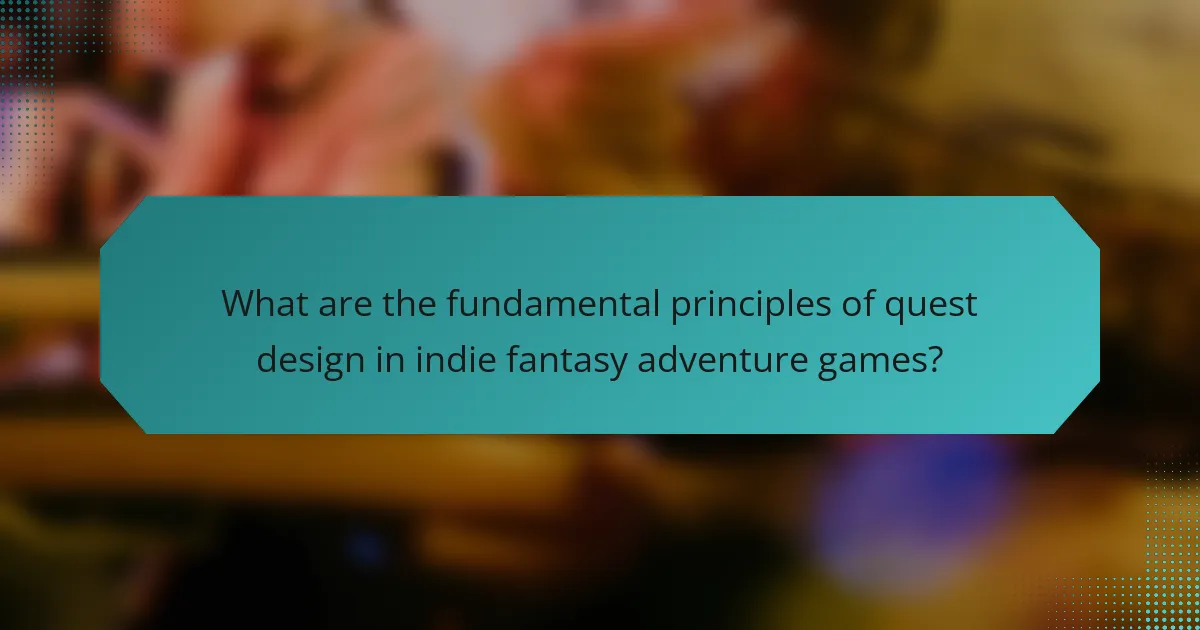Effective quest design in indie fantasy adventure games enhances player engagement and narrative depth. This article explores fundamental principles, variations in quest types, best practices, and common pitfalls in quest design. It highlights the importance of player agency, dynamic objectives, and environmental storytelling for immersive gameplay experiences. Additionally, it examines innovative designs in recent indie titles that prioritize meaningful choices and emotional storytelling.

What are the fundamental principles of quest design in indie fantasy adventure games?
The fundamental principles of quest design in indie fantasy adventure games include clear objectives, engaging narratives, and player agency. Effective quests balance challenge and reward, ensuring players feel invested in their choices.
A well-structured quest typically features a compelling hook, a series of challenges, and a satisfying resolution. Variations in quest types, such as fetch quests, puzzles, or story-driven missions, enhance gameplay diversity. Best practices involve iterative testing and player feedback to refine quest mechanics and narratives, fostering a more immersive experience.
How do narrative structures influence player engagement?
Narrative structures significantly enhance player engagement by creating immersive experiences. They guide players through emotional arcs, establish stakes, and foster connections with characters. Effective quest design utilizes linear, branching, and open-world structures to cater to diverse player preferences. These variations offer unique narrative experiences, allowing for exploration and choice, which keeps players invested. Additionally, incorporating player feedback into narrative development can further deepen engagement, ensuring that stories resonate with the audience.
Which elements contribute to immersive world-building?
Immersive world-building in indie fantasy adventure games relies on several key elements. These include rich storytelling, detailed environments, character development, and interactive gameplay mechanics. Each element enhances player engagement and creates a believable universe. For instance, layered narratives can provide depth, while vibrant visuals establish atmosphere. Additionally, player choices can influence outcomes, further immersing them in the game world.
What role do player choices play in quest outcomes?
Player choices significantly impact quest outcomes by determining narrative paths, character relationships, and game endings. These choices enhance player agency and immersion, making each playthrough unique. For example, a decision to ally with a character may lead to different quest rewards or alter the story’s progression. The variability in outcomes reflects the game’s design philosophy, emphasizing player engagement and replayability. Each choice can unlock new challenges or alter existing ones, showcasing the dynamic nature of indie fantasy adventure games.

How can quest objectives be effectively varied?
Varying quest objectives effectively enhances player engagement and narrative depth. Incorporate diverse objectives such as exploration, puzzle-solving, combat, and resource gathering.
Utilize environmental storytelling to create context-driven quests that encourage discovery. For example, players might uncover lore through item interactions or environmental cues.
Implement dynamic objectives that change based on player choices, fostering a sense of agency. This can include branching paths or varying outcomes based on player actions.
Lastly, integrate time-sensitive challenges or multi-part quests that require players to strategize and prioritize their actions, adding urgency and complexity to the gameplay experience.
What types of objectives enhance gameplay diversity?
Objectives that enhance gameplay diversity include varied quest types, dynamic challenges, and player-driven narratives. Incorporating combat, exploration, and puzzle-solving objectives keeps gameplay engaging. Unique attributes, such as time-sensitive missions or branching storylines, further enrich player experience. As a result, players encounter diverse scenarios that promote replayability and creativity.
How do environmental factors impact quest design?
Environmental factors significantly influence quest design by shaping player experiences and narrative depth. Elements such as terrain, climate, and cultural context create immersive settings that enhance storytelling and gameplay mechanics. For example, a quest set in a snowy landscape may require unique survival strategies, encouraging players to adapt their approach. Additionally, environmental storytelling can provide subtle clues, guiding players through quests and enriching the narrative. Integrating these factors fosters a dynamic interaction between players and the game world, ultimately improving engagement and satisfaction.

What are the most common pitfalls in quest design?
Common pitfalls in quest design include lack of clarity, poor pacing, and insufficient player agency. These issues can detract from player engagement and overall experience.
One major pitfall is failing to establish clear objectives, which can confuse players and lead to frustration. Another frequent mistake is uneven pacing, where quests either drag on or feel rushed, disrupting immersion. Lastly, limiting player choices can reduce the sense of agency, making quests feel linear and uninteresting.
Addressing these pitfalls involves ensuring clear communication of goals, maintaining a balanced flow, and providing meaningful choices to enhance player involvement.
Why do poorly designed quests lead to player frustration?
Poorly designed quests lead to player frustration because they often lack clarity, challenge, or engagement. When quests are ambiguous, players may feel lost and unsure of their objectives. A lack of meaningful choices can make gameplay feel monotonous and uninspired. Additionally, overly complex mechanics can overwhelm players, detracting from the enjoyment of the adventure. Effective quest design should balance challenge and clarity to enhance player experience.
What are the signs of a repetitive quest structure?
Repetitive quest structures often feature similar objectives, environments, and character interactions. Common signs include the same quest types appearing frequently, predictable reward systems, and a lack of narrative diversity. Players may notice reused dialogue, identical enemy types, and minimal changes in gameplay mechanics across quests. These elements can lead to a monotonous experience, diminishing player engagement.

Which innovative quest designs have emerged in recent indie titles?
Innovative quest designs in recent indie titles emphasize player choice and narrative depth. Games like “Disco Elysium” and “Hades” showcase branching narratives and dynamic character interactions, enhancing player engagement. Unique attributes include procedural generation in “Hades,” allowing for varied gameplay experiences. Additionally, titles like “Spiritfarer” focus on emotional storytelling, blending exploration with meaningful quest completion. These designs reflect a shift towards immersive and personalized gaming experiences in the indie scene.
What unique mechanics have changed the way quests are approached?
Unique mechanics have transformed quest approaches by emphasizing player agency and narrative depth. Interactive storytelling techniques allow players to influence outcomes, enhancing immersion. Non-linear quest structures encourage exploration and varied player experiences. Dynamic environments respond to player actions, creating a sense of consequence. Additionally, procedural generation introduces unpredictability, making each playthrough unique. These innovations foster richer engagement in indie fantasy adventure games.
How do cultural influences shape quest narratives in different regions?
Cultural influences significantly shape quest narratives in indie fantasy adventure games by reflecting regional values and traditions. Different regions incorporate local myths, historical events, and societal norms into their narratives, creating unique quest structures. For instance, quests in Eastern cultures may emphasize harmony and community, while Western narratives might focus on individual heroism and self-discovery. This diversity enriches gameplay, offering players varied experiences that resonate with their cultural backgrounds. Additionally, the incorporation of folklore can enhance immersion, making quests feel more authentic and relatable.

What best practices should indie developers follow for effective quest design?
Indie developers should prioritize player engagement, narrative depth, and balanced challenge for effective quest design. Focus on creating meaningful choices that impact the story and encourage exploration. Incorporate diverse quest types, such as fetch quests, puzzles, and combat challenges, to maintain variety. Utilize feedback from playtesting to refine quests and ensure clarity in objectives. Leverage unique attributes of the game world to enhance immersion and connect quests to the overarching narrative.
How can feedback loops improve quest effectiveness?
Feedback loops enhance quest effectiveness by enabling iterative improvements based on player experiences. Regularly collecting player feedback allows designers to identify strengths and weaknesses in quests. This process fosters engagement, as players feel their input shapes the game. Incorporating data from feedback loops can lead to more compelling narratives and balanced challenges, ultimately increasing player satisfaction and retention.
What strategies can be employed to balance challenge and accessibility?
Balancing challenge and accessibility in quest design involves integrating varied difficulty levels and clear guidance. Employ adaptive difficulty systems to adjust challenges based on player performance. Incorporate tutorials and hints to aid players without compromising the sense of achievement. Design quests that offer multiple solutions, catering to different playstyles. Utilize player feedback to refine quests, ensuring they remain engaging yet approachable.
Which resources are essential for refining quest design skills?
Essential resources for refining quest design skills include books, online courses, and community forums. Books like “The Art of Game Design” provide foundational knowledge. Online courses on platforms like Udemy offer practical insights. Community forums such as Reddit’s game design threads facilitate peer feedback and collaboration.
What common mistakes should indie developers avoid in quest design?
Indie developers should avoid common mistakes in quest design to enhance player engagement. Key errors include lack of clear objectives, overcomplicated narratives, insufficient pacing, and failure to incorporate player choices.
1. Lack of clear objectives can confuse players and lead to frustration.
2. Overcomplicated narratives may overwhelm players, making quests less enjoyable.
3. Insufficient pacing results in quests feeling rushed or dragging on unnecessarily.
4. Failing to incorporate player choices can diminish the sense of agency and investment in the game.
By addressing these issues, developers can create more compelling and enjoyable quest experiences.